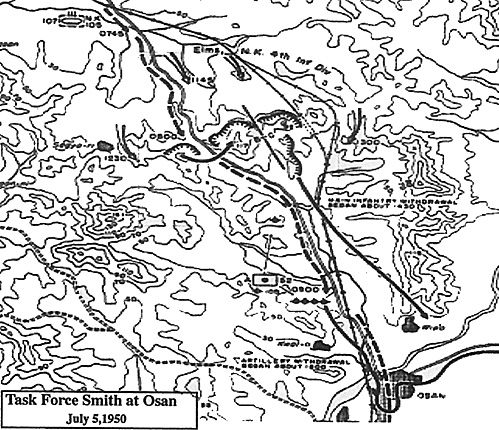After reading the first part of this article, I will think it is obvious that few players will want to play the first part of the battle unless they want to play a solitaire game with the T-34s driving through without stopping to fire, only firing ineffectual machine gun fire from bow and coax machine guns on the move. It is more a scenario of a shooting gallery, with trying to see how many hits you can roll before running out of the 6 HEAT rounds, or how many lucky critical hits you can roll with the poor quality bazookas.
Entering the second part of the battle, after the tanks have run through and the trucks of North Korean infantry come down the road, is where our main gaming potential comes in.
Historical Order of Battle
Task Force Smith
Elements of the 1st Battalion, 21st Infantry Regiment, 24th Infantry
Division:
Headquarters Company
B Company
C Company
BD of Regimental Communications Platoon
2 75mm Recoilless Rifles w /HE
2 4.2in Mortars w/ HE and Smoke
8 60mm Mortars w/ HE and Smoke
12 2.35in Bazookas
Battery A, 52nd Field Artillery with 6 towed 105mm Howitzers w 6
HEAT rounds, HE and Smoke
Total manpower - 406 men
Depending on which game rules system you use, and the men per figure ratio, assume the game Order of Battle as:
Battalion Commander with command group and radio
Battalion Executive Officer with command group and radio
2 Rifle Platoons of B Company with 1 Recoilless Rifle, 4 60mm Mortars, 6
Bazookas
2 Rifle Platoons of C Company with 1 Recoilless Rifle, 4 60mm. Mortars, 6
Bazookas
Half of Regimental Weapons Platoon: 2 4.2in Mortars, 4.30 cal Air
Cooled Machine Guns, 1.50 cal Air Cooled Machine Gun
Forward Observer Team w /land line communications
20 men from Regimental Signal Platoon with 2 radios and 2 land-line sets
1 6-gun battery of 105mm. Howitzers (1 used up front with the infantry
positions as anti-tank support, 5 off the south side of the table as artillery
support)
Since this is the first major action since the end of World War II, the US figures are best represented by WW II figures, while North Korean troops are well represented by WWII Russian or Communist Chinese in summer uniforms.
North Korean Order of Battle
Elements of the 107th North Korean Armor Regiment - 33 T-34/ 85 tanks,
late WWII models.
Elements of the North Korean 4th Infantry Division - 12,000 troops formed in Soviet- model Rifle Platoons.
Set-Up
From the numbers, this scenario looks a lot like a Rorke's Drift scenario, and to a point, it is. The scenario objectives are: North Korean troops are to get as many men through Smith's positions as quickly as possible; U.S. troops are to destroy as many North Korean elements as possible before fighting a withdrawal action off the South edge of the game map. See the map for initial positions and terrain within the boxed area representing our play area (note the position of the supporting 105mm howitzer). Smith's troops had all night to dig in prior to the morning attacks, so his troops are located in fox hole positions.
Smith will win the day only if he holds the enemy up for at least six hours and withdraws with at least 50% of his initial manpower.
Special Rules:
1. Artillery support - Historically, as the T-34s moved through the area, the land-line communications were cut between Smith's Forward Ob- server and the five guns in their rear. After that, signals were very spotty, and the guns played practically no role in supporting the infantry. As the game begins, the U.S. player or game master should roll one die for communications, with Smith being in communication on any even number and out of communication on an odd number. Begin each turn with another roll with the same odds. Any turn that communications is lost, there can be no artillery support. Depending on rules in play, remember to reduce the battery by one gun. There is ammo shortage in play, as the forward gun has only 6 HEAT rounds, and the guns in the rear have only the ammo on their 1BC ton trucks.
2. With the idea that the North Koreans would turn and run at the first sight of American soldiers in the area, it was thought that Smith would not need much ammunition. Each MG has only 4 boxes of ammunition, so use inherent low ammo rules after the 4th game turn following the deployment of the North Korean infantry. As the U.S. player starts taking casualties, troops may use inherent scrounging rules for replenishing ammo supplies for one more turn. Infantrymen are considered to carry enough ammunition for the day's mission.
3. Weather conditions are not in effect, as there is no appreciable wind and no precipitation.
If you enjoy playing the long shots, or are just interested in this period of history, the Task Force Smith scenario is one that must be played at least once. If you have ever played the British player in a Rorke's Drift game, you will feel right at home with Task Force Smith.

More Task Force Smith Korean War
Back to The Herald 39 Table of Contents
Back to The Herald List of Issues
Back to MagWeb Master Magazine List
© Copyright 2001 by HMGS-GL.
This article appears in MagWeb (Magazine Web) on the Internet World Wide Web. Other military history articles and gaming articles are available at http://www.magweb.com